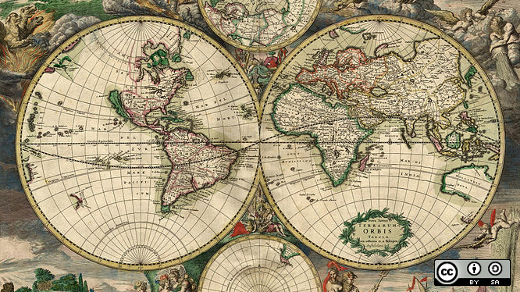In the world of geospatial technology, closed source solutions have been the norm for decades. But the tides are slowly turning as open source GIS software is gaining increasing prominence. Paul Ramsey, senior strategist at the open source company Boundless, is one of the people trying to change that.
Ramsey has been working with geospatial software for over ten years, as programmer and consultant. He founded the PostGIS spatial database project in 2001, and is currently an active developer and member of the project steering committee. Ramsey serves as an evangelist for OpenGeo Suite, works with the Boundless business development team to share about their collection of offerigns, and speaks and teaches regularly at conferences around the world.
In this interview, Ramsey shares with us how Boundless is trying to bring the open source revolution to GIS software.

Tell us a little bit about Boundless.
Boundless is the “Red Hat of geospatial”, which says a bit about our business model, but doesn’t really explain our technology. GIS professionals and IT professionals (and, really, anyone with a custom mapping problem) use our tools to store their data, in a spatial SQL database (PostGIS), publish maps and data over the web (GeoServer), and view or edit data in web browsers (OpenLayers) or on the desktop (QGIS). Basically, our tools let developers build web applications that understand and can attractively visualize location. We help people take spatial data out of the GIS department and use it to improve workflows and make decisions anywhere in the organization. This is part of what we see as a move towards what we call Spatial IT, where spatial data is used to empower decision-making across an enterprise.
Who is using your software?
Our stack is great for organizations building public-facing applications, because there is no economic blocker to scaling up for traffic: no per-node license or per-hit fee structure. So we have customers like: the Portland transit agency, TriMet, who publish a dynamic map of their transit system using our software; the Federal Communications Commission, who publish a map of broadband access; and New York City, who publish a real-time map of snow-plowing activity during storms.
Why is open source important to Boundless? Why take this business model and not a proprietary one?
Just like in the rest of IT, the availability of open source opens up a whole range of opportunities: students can easily make use of it, businesses can leverage it in unexpected ways when there’s no scalability tax, government organizations can more easily share their solutions with each other. So there’s a demand for this new model of software, and companies to support it. This is our sweet spot. Our roots were in solving a problem (ease of working with geospatial data) with a community approach. We have stayed true to that because that is part of our passion and our values, but we also want to see this penetrate into the enterprise and government markets and to do that, you need high level support. Our open source community has helped us perfect and expand the software since our first launch, and we have built an enterprise-class professional services group to give the support need for today’s complex applications.
How does Boundless evangelize the open source model in a market where closed source tool chains are still the predominant model for many in the field?
Closed source tool chains dominate our industry in the data creation side, but on the web and mobile application side is really quite a free-for-all of traditional proprietary software, software-as-a-service options, and open source. We think commercial open source spatial solutions offer the best of both worlds, a cloud-scalable solution that can still be deployed on-premise, but with the large feature-set and support users expect from proprietary software. What is comes down to is need. Developers need flexible options to meet the demands of their projects. While few are going to throw out the proprietary software they invested in over the years, they need tools likes ours to make their systems more useful and meet the demands we have today.
What does having a community edition mean for the OpenGeo Suite? How has having this resource available for free affected adoption?
It’s important that organizations be able to get on board with our tools without feeling like they are taking the first step down the path to lock-in. The community components are 100% open source, organizations can deploy them any way they want, and they are free to do whatever they want with them: that’s the open source guarantee. We want customers to engage with us as a positive option—because they want support, value our open approach to innovation, and want enterprise deployment options—not as a negative option, because they are forced to. We have seen large organizations and government agencies try our software for themselves before engaging as customers.
How does Boundless interact with the upstream code communities producing the open source projects which you convert into enterprise products?
We don’t think it’s possible to run a credible or effective open source support organization if you don’t have staff who are members of your core upstream communities. So for all the software we work with—PostGIS, GeoServer, GeoWebCache, OpenLayers, QGIS—we have staff who are community members, committers, and even leaders on the projects. When delivery schedules force it, we will occasionally maintain patches in our own repositories, but the economics and the ethics of open source dictate that it’s always best to migrate them upstream, and we do that regularly.
How is big data changing GIS, and how is Boundless preparing for a future where the size of datasets seem to continue to grow with no bounds?
Geospatial is a weird field, because we’ve been dealing with “big data” for a long time: map data is just naturally a lot larger than tabular data, and a lot more computationally intensive to process. That said, new data collection streams are hugely increasing the volume of data we have to deal with. We’re handling the growth in two ways: firstly, enhancing our existing software for easier cloud deployment and integration with cloud infrastructures (AWS services like S3, CloudWatch, RDS, EC2, etc); secondly, we’re adding connectivity to existing big data NoSQL systems, like MongoDB and Cassandra.
In the future, we’ll probably make spatializing big data analysis software like Hadoop part of our supported suite as well.And not only is the volume of spatial data growing, but so are the number of people working with and editing it. As maintaining simultaneous versions of spatial data becomes more difficult, it becomes all the more important to be able to independently update those versions, while retaining the capability to merge them together into a unified version at any point. To solve this challenge, we’ve released Versio, a distributed version control system designed specifically for spatial data. It provides fast and efficient ways for data authors to collaborate on spatial data while streamlining the creation, maintenance, and distribution of spatial data. No other solution has these capabilities.
What's next for Boundless? What are you hoping to accomplish in the coming months and years?
To paraphrase Steve Ballmer, “developers, developers, developers, developers!” We really want OpenGeo Suite and Versio to be obvious paths for building out modern spatial web applications, for both desktop and mobile. That means more development work on mobile, more packaging of common data sets for easy use, and more cloud deployment options, so developers and data analysts don’t necessarily need to host their own data and applications if they don’t want to.






Comments are closed.